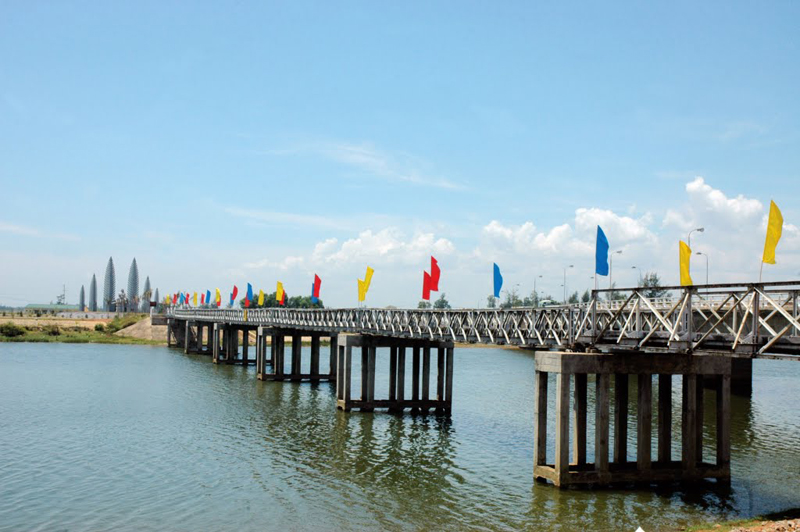
Quang Tri, which was the province capital of that area, is located in the Central Region of Vietnam, near the crossways between North and South Vietnam, Laos, and Thailand. The province preserves many remains from the anti-American resistance war such as the ancient citadel of Quang Tri, Khe Sanh Combat Base, Truong Son National Cemetery, Truong Son trail, Vinh Moc Tunnels, Hien Luong Bridge and Ben Hai River.
Sightseeing in DMZ
Hien Luong Bridge - Crosses the Ben Hai River at the middle of the DMZ and marks the former border between North and South Vietnam from 1954 to 1972 when the North Vietnamese Army captured Dong Ha town in the 1972 Easter Offensive and pushed the border to the Thach Han river in Quang Tri town, some 20 miles further south. During the partition of Vietnam, the bridge was painted with the two different colors. There is a monument on the north side.
Vinh Moc Tunnels - When the War took place in Vinh Moc from 1966 to 1972, the United States Army released over 9,000 tons of bombs in the area, with a ratio of 7 tons of bombs on average per person. But the local people didn't want to leave or lose their motherland. In 1965, they began to dig tunnels using simple tools beginning and completed them within two years. The total length of the tunnels is nearly 2,000 m long with 6 entrances to the tops of hills and 7 entrances to the South China Sea. The complex grew to include wells, kitchens, and rooms for each family and spaces for healthcare. Around 60 families lived in the tunnels; as many as 17 children were born inside the tunnels. Today, the tunnels are a tourist attraction and can be visited on organized tours. Beside individual tours to the tunnels, they are regularly part of full-day trips, starting from Hue to explore the Demilitarized Zone. In comparison to the Cu Chi tunnels, walking through the Vinh Moc tunnels is a lot more comfortable, because they are situated in a less humid climate zone and the height of the tunnels allows even western tourists to stand upright.
Truong Son National Cemetery - The largest martyr cemetery gathering grave of volunteer youth, soldiers who built up and fought to protect the legendary Ho Chi Minh Trail during American War. More than 10,000 graves dot these hillsides, each marked by a simple white tombstone headed by the inscription martyr. The gravestones of 13 war heroes, including two women, are singled out in a separate area. All other soldiers are buried in five zones according to the part of Vietnam they came from, with each zone further subdivided in to provinces. During the war, they would have been buried near where they killed, but after reunification their remains were transferred here or to one of the four other national cemeteries. However, many graves are empty, simply bearing names – a fraction of Vietnam’s 300,000 soldiers missing in action.
Camp Carroll - The largest fire base of the U,S Marines below the DMZ. There were 24 big guns there to provide fire support for the Marines. It was named after a Marine Corps captain who was killed while trying to seize a nearby ridge. Its gargantuan 175m cannons were used to shell targets as far away as Khe Sanh.
The Rockpile - A karst rock outcropping near the former South Vietnamese DMZ. It rises to an elevation of 240 meters (790 ft) MSL, about 210 meters (690 ft) above the surrounding terrain. Its relatively inaccessible location, reached only by helicopter, made it an important United States Army and Marine Corps observation post and artillery base from 1966 to 1968.
Dak Rong Bridge - Crossing the Dak Rong River 13km east of the Khe Sanh bus station, this bridge was rebuilt in 2001 and bears a marker hailing its importance as a conduit for the Ho Chi Minh Trail. The road to Aluoi was once part of the trail and heads southeast from the bridge.
Khe Sanh Combat Base – A United States Marine Corps outpost in South Vietnam used during the Vietnam War. The airstrip was built in September 1962. Fighting began there in late April 1967 with the hill fights, which later expanded into the 1968 Battle of Khe Sanh. U.S. commanders hoped that the North Vietnamese Army would attempt to repeat their famous victory at the Battle of Dien Bien Phu, and the battle ended as a failure for the North Vietnamese Army. The defense of Khe Sanh became one of the largest sieges of the war and commanded heavy international attention in the media one of several climactic phases of the Tet Offensive. On 5 July 1968, Khe Sanh was abandoned, the U.S. Army citing the vulnerability of the base to enemy artillery. However, the closure permitted the 3rd Marine Division to construct mobile firebase operations along the northern border area.
In 1971, Khe Sanh was reactivated by the U.S. Army (Operation Dewey Canyon II) to support Operation Lam Son 719, the South Vietnamese incursion into Laos. It was abandoned again sometime in 1972. In March 1973, American officials in Saigon reported that North Vietnamese troops had rebuilt the old airstrip at Khe Sanh and were using it for courier flights into the south. As of 2009, Khe Sanh Combat Base is a museum where relics of the war are exhibited. Most of the former base is now overgrown by wilderness or coffee and banana plants.
There are some special-theme tours available for those who want to tour around the DMZ area in Quang Tri and understand more about the Vietnam war. Those who are interested in this type of itineraries can check out some tour programs that started from Hue city to Quang Tri and DMZ area.